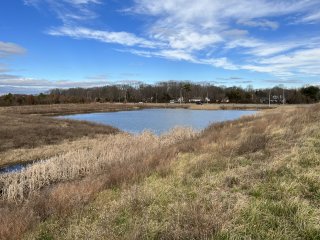Delaware Department of Transportation Finds Flexibility for Linear Transportation Projects in Stormwater Credits
Background
Long linear highway projects often have to acquire additional right-of-way (ROW) to construct required on-site stormwater control measures. Off-site stormwater management offers an alternative to this traditional approach, giving projects with limited ROW flexibility to construct stormwater control measures in areas outside the project site.
At a Glance
Location: Delaware
Mechanisms: stormwater credits
Geographic scope: Delaware Department of Transportation projects
Visit: Delaware Stormwater Credits Program
The Delaware Department of Transportation (DelDOT) is one of a group of permittees with coverage under the same municipal separate storm sewer system (MS4) permit in New Castle County; it also has coverage under an MS4 general permit for storm sewer systems it owns and operates in Kent and Sussex County. Both permits are issued by the Delaware Department of Natural Resources and Environmental Control (DNREC) and include post-construction stormwater management requirements that are met through compliance with the Delaware Sediment and Stormwater Program.
The Delaware 5101 Sediment and Stormwater Regulations, under Title 7 of the Delaware Administrative Code, set stormwater management offset provisions that enabled DelDOT to establish a stormwater offset bank. A memorandum of agreement between DNREC and DelDOT—first established in 1996, most recently updated in 2020—allows DelDOT to consider using off-site stormwater management to meet its on-site stormwater management performance requirements under certain conditions. Under this agreement, DelDOT created a stormwater credit bank to use for its own projects.
Program Details
DelDOT generates credits by building voluntary stormwater control measures outside regulated project areas or designing additional capacity into stormwater control measures constructed for compliance. Note that the Delaware regulations refer to stormwater control measures as best management practices (BMPs).

All stormwater control measures built to generate credits are subject to the same plan review, approval, construction inspection, as-built, acceptance, and maintenance requirements as stormwater control measures built as part of normal compliance on site. Those banked credits address pollutants relevant to roadway stormwater discharges and are used solely for other DelDOT projects rather than being traded or sold to outside entities. The potential credits generated by a stormwater control measure are calculated during plan review and approval using the Delaware Urban Runoff Management Model (DURMM), but credits are not deposited into DelDOT’s bank until the measure has been constructed and verified with as-built documentation.
When DelDOT’s stormwater credit bank was first established, credits were based on impervious area treated. In 2014, the Delaware Sediment and Stormwater Regulations were revised to include a new runoff reduction requirement: use of stormwater control measures to reduce the resource protection event volume (RPv), defined as a portion of the 1-year, 24-hour rainfall event based on a site’s land cover. RPv management uses practices designed to reduce the runoff to native meadow or forested condition via surface recharge, infiltration, evaporation, evapotranspiration, and delayed discharge (which mitigates the pollutant load in the discharge). To address these updated regulations, DelDOT changed the units for stormwater credits from acres of impervious area treated to cubic feet of RPv. One stormwater credit equals 1 cubic foot of RPv, and the credits may be used to partially or fully comply with the RPv requirements.
Another revision to the regulations, in 2019, requires that off-site stormwater management occur in the same 10-digit hydrologic unit code (HUC-10) as the project site, or in an adjacent HUC-10 within the same 8-digit HUC. To meet this requirement, DelDOT’s stormwater credit bank is divided into sub-accounts by HUC-10 watershed.
As of early 2023, DelDOT’s stormwater bank held about 320,000 cubic feet of RPv credits, generated from 12 projects. Three projects so far have used banked credits for RPv compliance on roadway and bridge improvement projects. Three more projects, now in the design phase, also plan to use banked credits for RPv compliance.
Benefits

Acquiring additional ROW for small road widening, intersection improvement, or bridge projects can be costly, difficult, and slow. When possible, DelDOT takes advantage of all acquired ROW to provide stormwater management beyond what is required for compliance. This generates credits, allowing DelDOT to maximize stormwater management benefits on sites where ROW is already available.
Lessons Learned
- Design programs that can adapt to regulatory change
- Credits were initially deposited into DelDOT’s stormwater credit bank in units of acres of impervious area treated, but were later converted to units of 1 cubic foot of RPv to adapt to changes in Delaware’s stormwater management regulations.
- Stormwater management regulations continue to evolve, so adaptively managing off-site stormwater management programs can help ensure their longevity.
